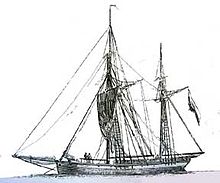Galiot
Galiots are sea-going, flat-bottomed round gatters . This type of ship - a further development of the Fleute - was originally developed in the Netherlands in the 17th century . It was used in coastal shipping and in the North and Baltic Seas . Due to the shallow draft , this type of ship was very popular in Pomerania .
Similar types were Smakken and Kuffen had a clumsy, but spacious hull and long side boards due to the requirements of the hold. Galiots had more favorable lines in the underwater area, so they were faster and did not need leverage.
Depending on the size and time, Galiots were rigged, ketch or hooker , brig , barque or full-ship rigged . There were numerous regional variants, such as B. the Eidergaliot, the Kuffgaliot or the Galiot ewer . However, many of the traditional terms can no longer be assigned to specific constructions. During the 19th century, was the bow of Galioten sharper, the stem received a major outage, overall, the lines were slimmer. Towards the end of the 19th century, Galiots were built in the traditional form of steel.
Galiots were primarily merchant ships, but were also used as smaller warships in the 17th century. However, at first these were probably only makeshiftly converted civil vehicles. Towards the end of the 17th century, however, a real warship was built in France based on the Galiot, the mortar ship or galiote à bombe. The Galiot was probably chosen for this role because of her solid construction and flat bottom, which allowed safe maneuvering near the coast.
literature
- Geyer, Lexow, son: three-masted galiot Friedrich-Wilhelm the 2nd . Model series, Hinstorff Verlag, Rostock 1990, ISBN 3-356-00323-2 .
- Menzel, Horst: Smacking, Kuffen, Galioten. Three almost forgotten types of ships from the 18th and 19th centuries . Hamburg, Kabel, 1997. ISBN 3-8225-0413-0

